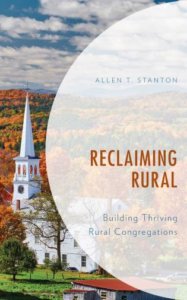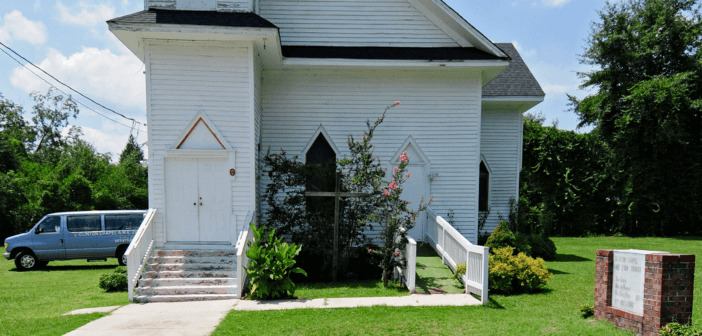Allen Stanton says rural churches need better indicators of what it means to thrive. He outlines three characteristics of vital rural congregations able to lead the wider community toward the Kingdom of God.
This article was originally published on June 15, 2021.
I pay attention to the way rural pastors describe their ministry. Often, they are apologetic. They presume their churches are deficient because they try to adhere to a notion of viability that was not engineered for their communities or contexts. With imaginations beset by the “grow or die” mindset, they want to attract more people to worship, even as their community’s population stagnate. Or they seek to launch youth programs in the midst of new retiree communities.
These churches need better indicators of what it means to thrive. I believe a vital rural congregation is one that recognizes and acts on its ability to lead the wider community to participate in the Kingdom of God. This is, I believe, a theological, social, and evangelical vision for the rural church. Three indicators can help congregations sustain such a vision and reclaim a narrative of vitality.
1. A thriving rural church has a clear theological identity.
Every organization needs a clear focus and mission, around which the practices of the organization are built. For congregations, our theology is that foundation. In theory, that seems obvious. In practice, it is usually a bit more difficult.
What makes a church a church? When I lead workshops, I ask this question, and more often than not, the answers reveal a bias toward organizational structure. Church leaders tend to focus on the things they spend the most amount of time worrying about, like money, volunteers, and good programs. This is not surprising. Spirituality is often seen as deeply personal. Theology is viewed as theoretical, often without any real implications to operations. So, the primary goal becomes staying open and operational. Organizational structure does matter, but in many scenarios, it can dictate the theological vision of the church rather than empower and support the vision.
For the church, theology is not just about mission and productivity. Our beliefs should permeate the culture. Key to this is the recovery of vocation within the church. A church with a clear theological identity can produce laity who connect their lives to a sense of Divine call, uncovering what it means for them to be faithful as a business owner, a teacher, an elected official, or a scientist. A vital church is a place to form people who can, with a deep and grounded theology, respond to God’s call with “This is what I have been equipped to do.”
2. A thriving rural church has a commitment to community.
Rural churches are often one of only a few permanent stakeholders in a community. They have a long presence in the community. They have seen how the community has changed and grown over the years. A vital congregation takes that a step further, connecting the story of the community to the story of God. They can see how God has been and is at work in the community, and they are eager to join in with that work. They eagerly look to uncover potential and opportunities, and they see themselves among the assets of a community.
As churches seek to uncover the story of their community, they must be careful not to default to preexisting narratives. Small-member churches naturally tend to default to the caring cell, which can narrow the story significantly. A church of middle-class seniors might believe that the entire community looks and acts like they do: aging, retired, and with a strong social circle. Without talking to any other members of the community, they have unwittingly defaulted to a narrow narrative about their place, leaving out young adults, working professionals, other income levels, and other demographics.
A congregation committed to the community knows that community well. And, because of their theological and spiritual formation, they know their responsibility to the community. They are taking steps to live out that responsibility in creative, imaginative ways, utilizing the resources they find along the way.
3. A thriving rural church practices good stewardship.
Generally, when churches talk about stewardship, they tend to immediately focus on financial stewardship. A thriving rural congregation should obviously be able to cover the cost of overhead, keeping the lights on and the doors open. Such a narrow view of stewardship, though, will unfortunately narrow missional imaginations, forfeiting the opportunity to explore the full assets of the congregation.
In truth, churches generally work with far more assets than they realize. Volunteers provide countless in-kind hours. Church property that goes unused through the week means that billions of dollars’ worth of assets are being underutilized, while every community has groups looking for meeting spaces.
To be blunt, the rural church’s greatest mission resource is not usually their finances. Churches will not be leaders in the community simply based on the amount of money they pour into mission projects. Rather, churches should be clear about the assets they bring to the table and what role they might play in the existing community ecosystem. What are the strengths and talents of the people in the congregation? What other community groups and organizations are doing work in the areas in which your church is interested? Can your space be an asset? Do you have volunteers?
Good stewardship means that churches are utilizing all of their resources to live out their vocation as a congregation. Grounded in their theological identity and commitment to the community, they can name their asserts, cultivate partnerships, and deploy their resources to help the wider community recognize the reality of the Kingdom of God.
 This article is condensed and adapted from Reclaiming Rural: Building Thriving Rural Congregations (Rowman and Littlefield, 2021) by Allen T. Stanton. The book is available from the publisher, Cokesbury, and Amazon.
This article is condensed and adapted from Reclaiming Rural: Building Thriving Rural Congregations (Rowman and Littlefield, 2021) by Allen T. Stanton. The book is available from the publisher, Cokesbury, and Amazon.
Related Resources
- 3 Unique Gifts of the Rural Church by Allen T. Stanton
- A New Way to View Vitality in Smaller Congregations by Lewis A. Parks
- Small Church Big Impact by Blake Bradford
- Doing Community Ministry in the Small Church by Joy F. Skjegstad
If you would like to share this article in your newsletter or other publication, please review our reprint guidelines.
Photo by Bill Fitzpatrick, CC BY-SA 3.0, via Wikimedia






